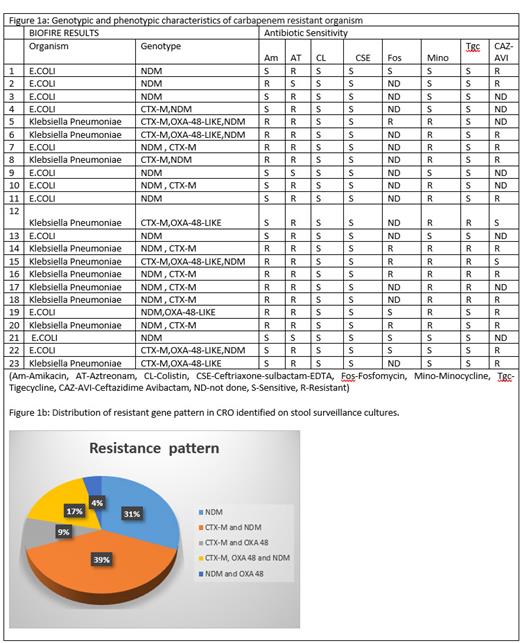Introduction
Patients undergoing hematopoietic stem cell transplant (HSCT) are at high risk of life-threatening bacterial infections. Although the prevalence and pattern of resistance varies amongst centres and countries, there is a growing global problem of resistance to antibiotics. The increased use of broad-spectrum antibiotics and injudicious antibiotic policies have contributed to the selection of multidrug resistant(MDR) pathogens. Translocation of organisms which normally colonize the gut into the bloodstream during the febrile neutropenia has long been postulated as a pathogenic factor for life-threatening gram-negative infections.
We routinely do stool surveillance culture of all patients admitted for autologous and allogenic stem cell transplant to guide us on empirical antibiotic usage. This analysis was conducted to evaluate the incidence of carbapenem resistant organisms (CROs) and their molecular pattern of resistance in stool surveillance cultures.
Methods
This is a single centre retrospective analysis of patients who underwent autologous and allogenic stem cell transplant for haematological malignancies from December 2021 to January 2023. In all patients stool surveillance cultures were sent at baseline during admission and then weekly thereafter till discharge . A blood Biofire syndromic multiplex PCR was performed in a fraction of stool isolates to identify the gene responsible for carbapenem resistance. Biofire syndromic multiplex PCR was performed only once for one patient on the first stool culture that grew a CRO. Biofire is a multiplex PCR that identifies Gram negative organisms including Acinetobacter Baumanni, Bacteroides Fragilis, Enterobacter cloacae, E. coli, Klebsiella, Proteus, Salmonella, Serratia, H. influenza, Neisseria meningitides, Pseudomonas aeruginosa, Stenotrophomonas maltophilia; it also identifies the gene responsible for resistance. The Carbapenem resistant genes included in the Biofire syndromic multiplex PCR were IMP Carbapenemase, KPC Carbapenamase, OXA-48, NDM, VIM, CTXM.
Results
Seventy-one patients underwent HSCT from December 2021 to January 2023. These included 39 allogenic and 32 autologous stem cell transplants. The median age of the cohort was 33 years (range 3-63 years) with 48 males and 23 females. The diagnoses were AML(n=8), ALL(n=14), CML(n=14), HL(n=10), Multiple Myeloma(n=19), Myelofibrosis(n=1), Non-Hodgkin Lymphoma (n=5).
A total of 430 stool surveillance cultures from 71 patients were analysed. Of 430, 90 (20.9%) stool samples in 30 (42%) patients grew carbapenem resistant organism. Of these 90 CROs, twenty-three stool culture isolates belonging to 23 different patients were analysed for genotypic resistance.
These 23 CROs included Escherichia coli 12 (52%) and Klebsiella pneumonia 11 (48%). On phenotypic sensitivity testing, the CROs were sensitive to Ceftriaxone-Sulbactam-EDTA (23/23, 100%), Ceftazidime-Avibactam (2/15, 13%), Colistin (23/23, 100%), Aztreonam (3/23, 13%), Tigecycline (17/23, 74%), Minocycline (9/23, 39%) and Aminoglycosides (11/23, 48%) shown in Figure 1a
Resistance gene panel in these 23 stool isolates revealed NDM alone in 7 (31%), CTX-M along with NDM in 9 (39%), CTX-M along with OXA 48 like in 2(9%), CTX-M, OXA 48 along with NDM in 4 (17%) and NDM with OXA 48 in 1 (4%) (Figure 1b).
Of the remaining 67 stools in which Biofire was not performed, Escherichia coli grew in 31 (46%) and Klebsiella pneumonia grew in 35 (52%) and Pseudomonas Aeruginosa in 1 (2%). On drug sensitivity testing, these CROs were sensitive to Ceftriaxone-Sulbactam-EDTA (65/67, 97%), Ceftazidime-Avibactam (4/15, 26%), Colistin (65/67, 97%), Aztreonam (7/65, 11%), Tigecycline (39/57, 68%), Minocycline (24 /62, 39%) and Aminoglycosides (33/67, 49%).
Conclusion:
About 40% of our patients were colonized with CROs at some point during their transplant. Molecular patterns identified NDM alone or in combination with other resistance genes in more than 90% of stools where molecular testing was performed. The antibiotics to which these MDR organisms were most susceptible included Ceftriaxone-sulbactam-EDTA, Colistin and tigecycline. Our study suggests that NDM is the most common resistance gene responsible for carbapenem resistance in our patients. Thus, antibiotics or antibiotic combinations that target NDM should be considered early in patients with MDR sepsis.
Disclosures
No relevant conflicts of interest to declare.


This feature is available to Subscribers Only
Sign In or Create an Account Close Modal